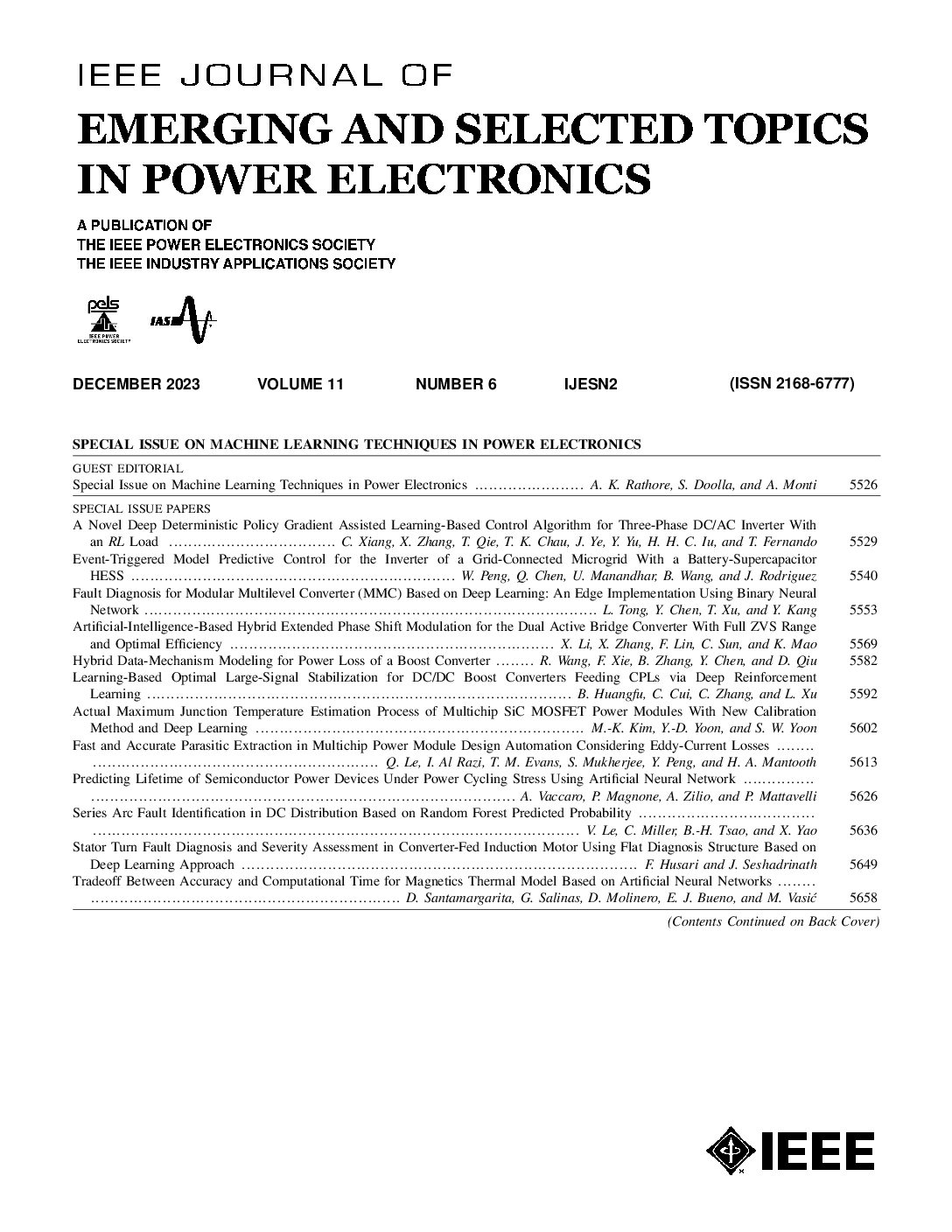Single-Rating Multilevel Current Source Inverter With Fault Tolerance
IF 4.6
2区 工程技术
Q1 ENGINEERING, ELECTRICAL & ELECTRONIC
IEEE Journal of Emerging and Selected Topics in Power Electronics
Pub Date : 2024-07-24
DOI:10.1109/JESTPE.2024.3432888
引用次数: 0
Abstract
The paralleled H-bridge multilevel current source inverter (PHB-MLCSI) provides a practical means to enhance both the system’s current rating and power quality simultaneously. Even so, challenges such as separate dc sources and the need for bulky input dc inductors present notable obstacles in the PHB-MLCSI with an independent dc-link configuration, potentially increasing the system’s cost and size. The PHB-MLCSI with a shared dc-link, also known as the single-rating MLCSI (SR-MLCSI), can overcome these limitations. However, the SR-MLCSI faces the issue of open-circuit fault (OCF), similar to other traditional CSIs. Recently, a topology known as paralleled H-bridge multilevel switching-cell current source inverter (PHB-MLSC2SI) has been proposed in the literature to address the OCF issue in conventional PHB-MLCSI. However, this topology retains the same limitations as those mentioned for PHB-MLCSI. This article proposes a modified version of SR-MLCSI, termed SR-MLCSI with fault tolerance (SR-MLCSIFT), to address the OCF issue in SR-MLCSI and mitigate the size, weight, cost, and complexity drawbacks of PHB-MLCSI and PHB-MLSC2SI. Additionally, the article investigates several extremely severe faulty scenarios for the first time within the proposed topology. A detailed operational principle of the suggested inverter under OCF conditions is provided, accompanied by a comprehensive comparison with several MLCSI counterparts. Extensive experimental tests are conducted to validate the effectiveness of the proposed solution.具有容错能力的单额定多电平电流源逆变器
并联 H 桥多级电流源逆变器(PHB-MLCSI)为同时提高系统的额定电流和电能质量提供了一种实用方法。尽管如此,独立直流源和需要大体积输入直流电感器等挑战仍是采用独立直流链路配置的 PHB-MLCSI 的显著障碍,可能会增加系统的成本和体积。具有共享直流链路的 PHB-MLCSI(也称为单额定 MLCSI(SR-MLCSI))可以克服这些限制。然而,SR-MLCSI 与其他传统 CSI 类似,也面临着开路故障(OCF)问题。最近,文献中提出了一种拓扑结构,即并联 H 桥多级开关单元电流源逆变器(PHB-MLSC2SI),以解决传统 PHB-MLCSI 的开路故障问题。然而,这种拓扑结构仍然存在与 PHB-MLCSI 相同的局限性。本文提出了 SR-MLCSI 的改进版本,称为具有容错功能的 SR-MLCSI(SR-MLCSIFT),以解决 SR-MLCSI 中的 OCF 问题,并减轻 PHB-MLCSI 和 PHB-MLSC2SI 在尺寸、重量、成本和复杂性方面的缺点。此外,文章还首次在所建议的拓扑结构中研究了几种极其严重的故障情况。文章提供了所建议的逆变器在 OCF 条件下的详细工作原理,并与几种 MLCSI 同类产品进行了全面比较。为验证所提解决方案的有效性,还进行了广泛的实验测试。
本文章由计算机程序翻译,如有差异,请以英文原文为准。
求助全文
约1分钟内获得全文
求助全文
来源期刊

IEEE Journal of Emerging and Selected Topics in Power Electronics
ENGINEERING, ELECTRICAL & ELECTRONIC-
CiteScore
12.50
自引率
9.10%
发文量
547
审稿时长
3 months
期刊介绍:
The aim of the journal is to enable the power electronics community to address the emerging and selected topics in power electronics in an agile fashion. It is a forum where multidisciplinary and discriminating technologies and applications are discussed by and for both practitioners and researchers on timely topics in power electronics from components to systems.
 求助内容:
求助内容: 应助结果提醒方式:
应助结果提醒方式:


